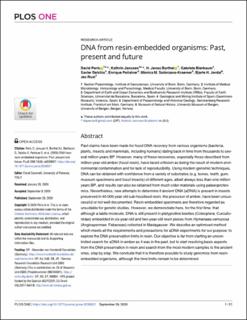| dc.contributor.author | Peris, David | |
| dc.contributor.author | Janssen, Kathrin | |
| dc.contributor.author | Barthel, H. Jonas | |
| dc.contributor.author | Bierbaum, Gabriele | |
| dc.contributor.author | Delclòs, Xavier | |
| dc.contributor.author | Peñalver, Enrique | |
| dc.contributor.author | Solórzano-Kraemer, Mónica M. | |
| dc.contributor.author | Jordal, Bjarte Henry | |
| dc.contributor.author | Rust, Jes | |
| dc.date.accessioned | 2021-05-07T12:55:51Z | |
| dc.date.available | 2021-05-07T12:55:51Z | |
| dc.date.created | 2020-12-14T22:35:27Z | |
| dc.date.issued | 2020 | |
| dc.Published | PLOS ONE. 2020, 15 (9), . | |
| dc.identifier.issn | 1932-6203 | |
| dc.identifier.uri | https://hdl.handle.net/11250/2754199 | |
| dc.description.abstract | Past claims have been made for fossil DNA recovery from various organisms (bacteria, plants, insects and mammals, including humans) dating back in time from thousands to several million years BP. However, many of these recoveries, especially those described from million-year-old amber (fossil resin), have faced criticism as being the result of modern environmental contamination and for lack of reproducibility. Using modern genomic techniques, DNA can be obtained with confidence from a variety of substrates (e.g. bones, teeth, gum, museum specimens and fossil insects) of different ages, albeit always less than one million years BP, and results can also be obtained from much older materials using palaeoproteomics. Nevertheless, new attempts to determine if ancient DNA (aDNA) is present in insects preserved in 40 000-year old sub-fossilised resin, the precursor of amber, have been unsuccessful or not well documented. Resin-embedded specimens are therefore regarded as unsuitable for genetic studies. However, we demonstrate here, for the first time, that although a labile molecule, DNA is still present in platypodine beetles (Coleoptera: Curculionidae) embedded in six-year-old and two-year-old resin pieces from Hymenaea verrucosa (Angiospermae: Fabaceae) collected in Madagascar. We describe an optimised method which meets all the requirements and precautions for aDNA experiments for our purpose: to explore the DNA preservation limits in resin. Our objective is far from starting an uncontrolled search for aDNA in amber as it was in the past, but to start resolving basic aspects from the DNA preservation in resin and search from the most modern samples to the ancient ones, step by step. We conclude that it is therefore possible to study genomics from resin-embedded organisms, although the time limits remain to be determined. | en_US |
| dc.language.iso | eng | en_US |
| dc.publisher | Public Library of Science | en_US |
| dc.rights | Navngivelse 4.0 Internasjonal | * |
| dc.rights.uri | http://creativecommons.org/licenses/by/4.0/deed.no | * |
| dc.title | DNA from resin-embedded organisms: Past, present and future | en_US |
| dc.type | Journal article | en_US |
| dc.type | Peer reviewed | en_US |
| dc.description.version | publishedVersion | en_US |
| dc.rights.holder | Copyright 2020 Peris et al. | en_US |
| dc.source.articlenumber | e0239521 | en_US |
| cristin.ispublished | true | |
| cristin.fulltext | original | |
| cristin.qualitycode | 1 | |
| dc.identifier.doi | 10.1371/journal.pone.0239521 | |
| dc.identifier.cristin | 1859779 | |
| dc.source.journal | PLOS ONE | en_US |
| dc.source.40 | 15 | |
| dc.source.14 | 9 | |
| dc.identifier.citation | PLOS ONE. 2020, 15 (9), e0239521. | en_US |
| dc.source.volume | 15 | en_US |
| dc.source.issue | 9 | en_US |

